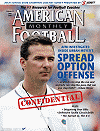AMERICAN FOOTBALL MONTHLY THE #1 RESOURCE FOR FOOTBALL COACHES
Article CategoriesAFM Magazine
|
The Beauty of the High/Lowby: Marc Kolb© More from this issue Creating quick reads for your quarterback that can lead to receivers gaining big yards after the catch. The beauty of the high/low read is how it can create success for every position group on the field. We succeed with big receivers or fast receivers and with strong-armed quarterbacks or smaller, more athletic quarterbacks. In addition, it creates a quicker passing game so the offensive line does not have to protect too long. It even creates an immediate blitz throw for the quarterback without having to use hot principles. The quarterback is able to get rid of the ball relatively quickly and has a simple, consistent read while our receivers have a chance to gain yards after the catch. In any passing attack the quarterback is ultimately the limiting factor to....The full article can only be seen by subscribers. Subscribe today!
|
|
|||||||
| HOME |
MAGAZINE |
SUBSCRIBE | ONLINE COLUMNISTS | COACHING VIDEOS |
Copyright 2025, AmericanFootballMonthly.com
All Rights Reserved





